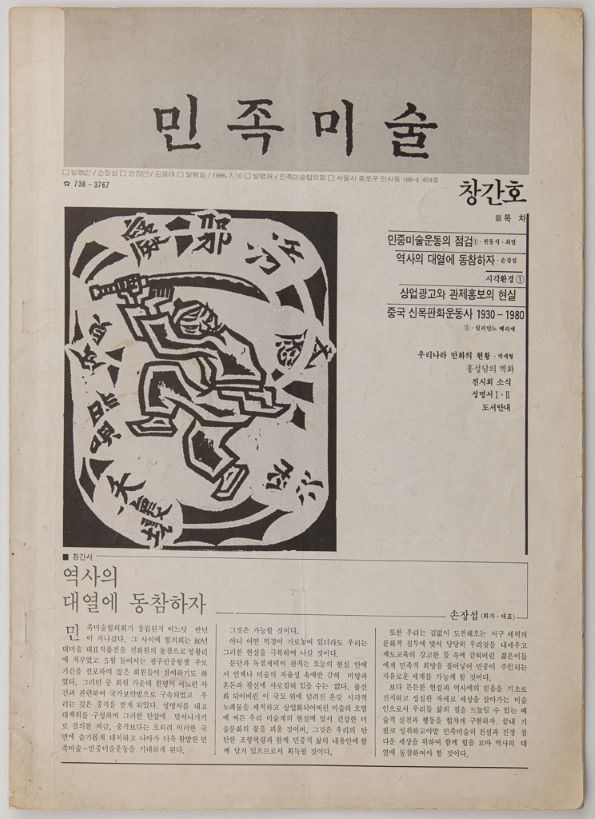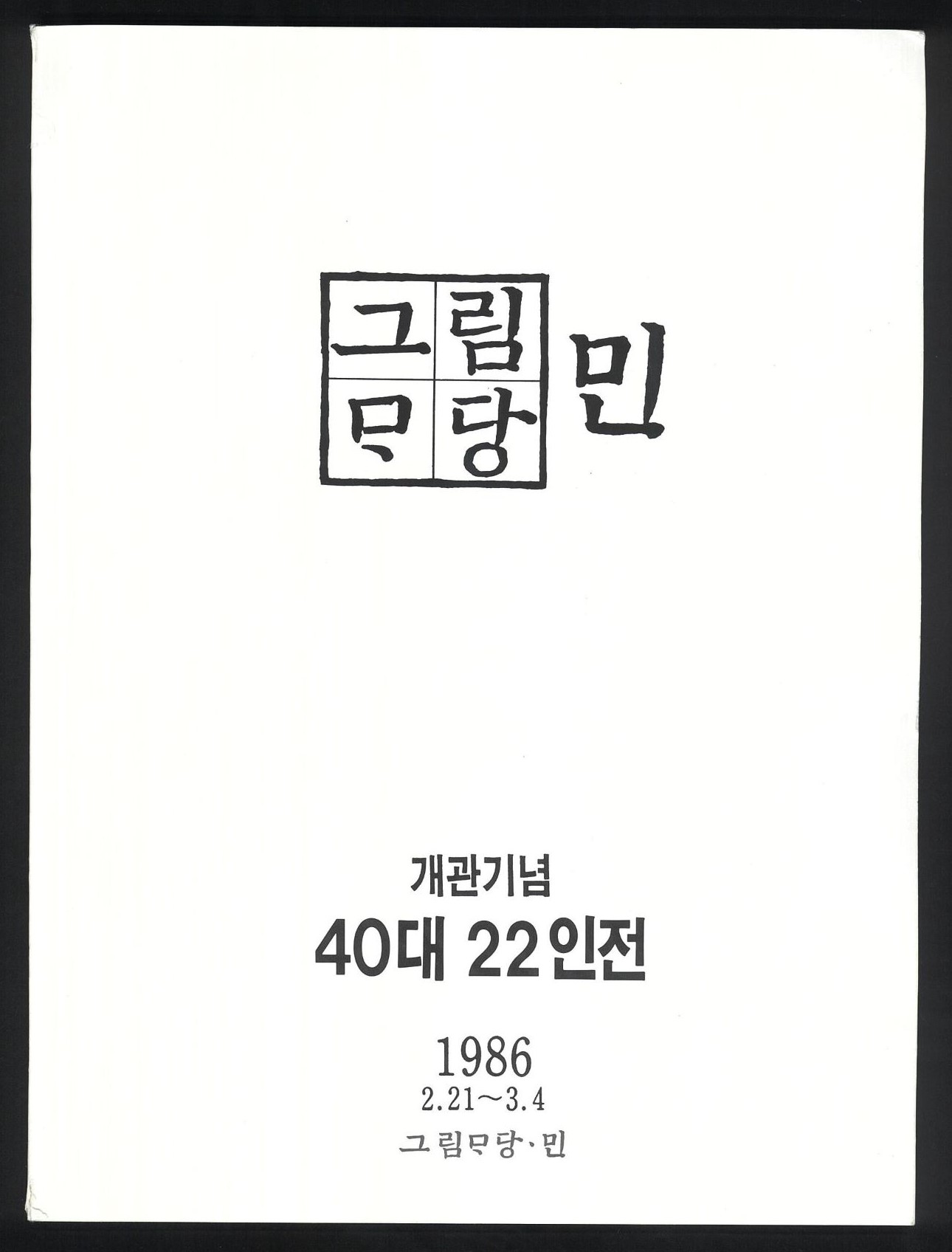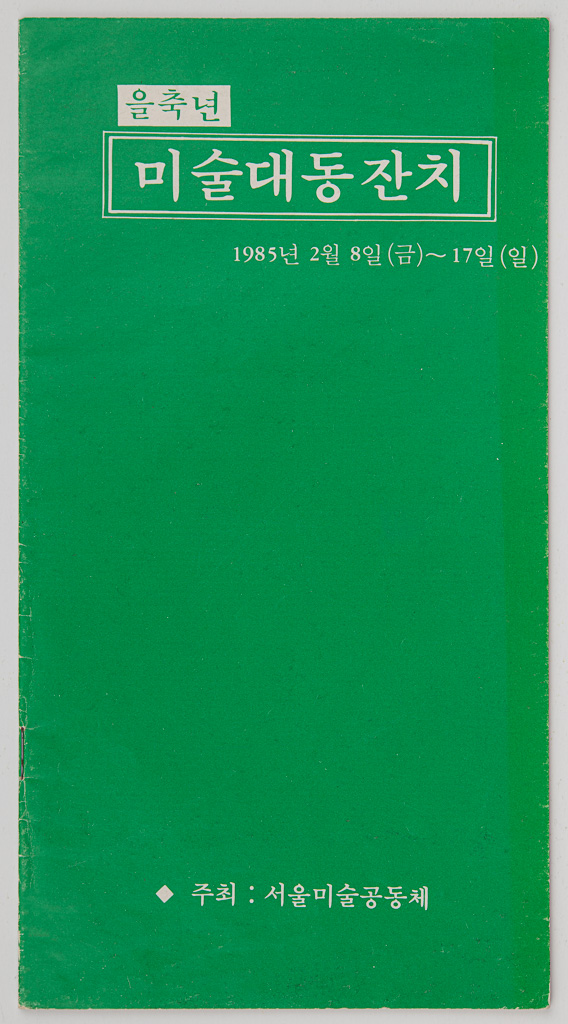
Time Spirit Exhibition, Brochure, 1983, MMCA Art Research Center Collection
Sidaejeongsin (Zeitgeist)
* Source: Multilingual Glossary of Korean Art. Korea Arts Management Service
Related
-

Minjung Art
An artistic movement that came to prominence alongside Korea’s democratization movement in the 1980s. Minjung artists often sought to critically portray the violent repression and corruption of the military dictatorship, to represent the experiences of laborers and farmers, and to achieve social change through art. In contrast to abstraction, which constituted the mainstream of 1970s art in Korea, Minjung Art is notable for the use of representational and figurative forms. One possible point of origin for Minjung Art is Oh Yoon’s work in the Reality Group (Hyeonsil dongin). The group was formed in 1969 by Kim Ji-ha, Oh Yoon, and Lim Se-taek. A variety of Minjung art groups were established, including the Reality and Utterance (Hyunsilgwa bareon) in 1979 by Kim Jungheun, Oh Yoon, Joo Jae-hwan, art critic Sung Wan-kyung, and Choi Min, the Gwangju Freedom Artist Association (Gwangju jayu misulin hyeopuihoe) in 1979 by Hong Sungdam and Choi Youl, the Imsulnyeon (The Year Imsul) in 1982, and the Dureong in 1983. These groups all commonly critiqued Western capitalism. In terms of form, Minjung artists adopted traditional and ethnic folk modes of expression using diverse media such as collage, printmaking, oil painting, and photography. Following the 15 Years of Korean Minjoong Arts: 1980-1994 Exhibition at the National Museum of Modern and Contemporary Art, Minjung Art became an accepted part of Korean art history. Overseas, Minjung Art has also become a recognized term that describes this genre and its unique focus on the political and social history of Korea.
-

National Art Association
An art association established in November 1985 by a collective of grassroots artists, and often also referred to as Minmihyeop. The association sought to organize artists and groups who represented the different movements within Minjung Art and to represent their varied ideas and interests. In 1995, the original association was reformed into the National Korean People’s Artists Association [Jeonguk minjok misurin yeonhap]. In turn, this was the predecessor of the Korean People’s Artists Association [Minjok misurin hyeophoe], a corporation founded in 2000.
-

Min Art Gallery
A notable exhibition space for minjung art that was established in 1986 by the National Art Association. The gallery formed during heightened political tensions after the military dictatorship’s censure of the The Year 1985, Power of the Art by the Twenties exhibition, which was held in 1985. The gallery hosted the Bangomunjeon, a direct critique of political reality, and it also held feminist art exhibitions such as the Women and Reality exhibitions from 1987 to 1993, which were organized by the Women’s Art Research Society [Yeoseong misul yeonguhoe]. In addition to art exhibitions, the gallery hosted film festivals, seminars, and educational programs as well as serving as a venue for discourse on the future direction of minjung art. After minjung art lost momentum in the beginning of the 1990s, financial difficulties caused the gallery to close in 1994.
Find More
-

Silcheon Group
An alumni group of Hongik University, which was formed in 1983 by Park Hyeongsik, Son Kihwan, Lee Gyumin, Lee Myeongjun, Lee Sangho, Lee Seop, Lee Jaeyeong, and Cho Jongsik. The group held its inaugural exhibition at Kwanhoon Gallery. The group advocated “art in society,” published The Harmony of Art and Poetry—an album of poetry and paintings—and held a themed exhibition title Mass Media and Reality. In the context of the heightened political tensions during the 1980s, the group focused on the denouncement of reality and the use of visual shock for the purposes of ridiculing, mocking, scorning, and satirizing reality, rather than in the pursuit of aesthetic value.
-

Seoul Art Coalition
The Seoul Art Coalition (SAC) was a solidarity community of small groups in the Seoul area that was formed in 1984 and was active until 1987. From October 1 to 3 in 1983, the “Three Days and Three Nights Discussion” was held in Daeseong-ri, Gapyeong, Gyeonggi-do Province. At the time, Ok Bonghwan, Kim Bongjun, Moon Youngtae, Chang Jinyoung, Choi Minhwa, Choi Youl, Hong Seonwung, and Hong Sungdam gathered to discuss the nature, direction, and challenges of an art movement. They decided to promote an art movement based on solidarity. It was agreed that each region would form an “art community” based not on the critical realism of “Reality and Utterance” but on folk realism. The idea was to form art communities in Seoul, Gwangju, Busan, Incheon, Jeju, and other regions and grow them into a national organization. Choi Minhwa immediately discussed the concept of an art coalition with Yoo Yeunbok and Park Jinhwa. Choi was designated as the person in charge of cartoons, Yoo Yeunbok for mural paintings, and Lee Ki-jung for prints. From January 1984, the SAC began hosting open forums to restore and build a healthy art. It compiled materials and printed 200 copies of Hyeondae misul (Contemporary art). In June of the same year, its members participated in Life Portrayed by 105 Artist, and in September they held an inaugural meeting for the “art coalition” and elected Choi Minhwa as the first director of planning. In October, the SAC published a print calendar Poems and Woodcut Calendars (Woorimadang). The SAC was officially launched in February 1985. The small groups that joined the SAC include Silcheon (Geurim dongin Silcheon), Hoengdan, Namu [Mokpan moin namu], Espa, the Committee of Sidaejeongsin(Zeitgeist) [Sidae jeongsin gihoek wiwonhoe], Mural Painting Organization Sipjangsaeng [Byeokhwa giheok sipjangsang], and Uksae. Its purpose was to “creatively develop the rich formal values of visual arts, fight against any factors that restrict free expression, and seek ways for artworks to be committed to the lives of people.” Simultaneously with its launching, the SAC held art fairs for the populace, such as Eulchuknyeon Group Art Festival and the Gangnam Art Market. In April, it published its bulletin Misul gongdongche (Art community). The publication continued until 1986 with a total of five volumes. In May, the SAC created and posted a hanging painting at the May Third Incheon Laborers Conference. In June, the first general assembly was held, and Son Kihwan was elected as the second director of planning. In July, Son Kiwhan, Park Jinhwa, and Park Buldong curated the exhibition Power of the Art by the Twenties but the police arrested the artists and confiscated their works. In February 1986, the Byeonginnyeon Group Art Festival was held at the Arab Art Museum. At the second general assembly in March, Yoo Yeunbok was elected as the third director of planning, and at the third general assembly in 1987, Park Jinhwa was elected as the fourth director of planning. On June 17, 1986, the SAC painted the mural Joy of Unification on the building in front of Sinchon Station, and on July 26, it did the mural Co-Living on the wall of Yoo Yeunbok’s house. These two murals were defaced by the state. Those who created the latter, including Yoo Yeunbok, Kim Jinha, Choi Byungsoo, Hong Hwanggi, and Kim Yongman, were indicted without detention. The SAC organized the exhibition Satire and Humor in August and the exhibition Art and Politics at Great Transition, in November 1987. In January 1988, the SAC members discussed its dissolution at a restaurant in Insa-dong and then disbanded. The SAC is the first collective of small groups that was formed after the agreement on turning the national organizations of Minjung art movement into art communities was made. They accomplished significant achievements in the popular art movement, mural movement, and art discourse.
-

Hoengdan
Hoengdan was the name of an art group which was active only briefly from 1980 to 1983, and it was also the theme of their exhibition. Its establishment started from a reflection on Korean contemporary art in the 1970s, by artists who believed that art cannot turn a blind eye to social reality. The principal active members of Hoengdan included Kim Jinyeol, Kim Bo-jung, Jung Bocsu, Ko Kyeong-hun, Ahn Gyeonghui, Song Simi, Lee Gapyeol, and Park Geon. Hoengdan held their first exhibition from August 28 through September 3, 1980 in the Room B of the Exhibition Hall 1 at the Misulhoegwan (now ARKO Art Center). The exhibition themed around “two-dimensional works for three walls” was curated and participated by three artists, Kim Jinyeol, Chang Sukwon, and Ham Yeon-sik. It featured twenty experimental works. Their second exhibition was held from May 29 through June 3, 1981 at Kwanhoon Gallery. Kim Bo-jung, Kim Jinyeol, Song Simi, Chang Sukwon, and Ham Yeon-sik participated in it. The works displayed in the first and second exhibitions were rather abstract and experimental. However, from 1982 onward, concrete forms began to appear in their works. As a case in point, through his People series, Kim Jinyeol depicted the daily lives of ordinary people and the social oppression they experienced. Other artists also revealed unfortunate premonitions inherent in everyday lives and projected the bleak social conditions of the early 1980s onto their works. In 1982, Hoengdan participated in the exhibition The Innocence of Conscience: That Sound, which was organized by the DAMU Group and held at Kwanhoon Gallery, along with small art groups Jeongae, DAMU Group, and TARA. In 1983, it organized the exhibition Noise, Confusion, and Disturbance held from May 4 to 10 at Kwanhoon Gallery. Its third exhibition was held from November 24 to 30, 1983. Afterward, the group’s activities were discontinued. The discontinuation is not unrelated to the quick migration of the major players among figurative artists to the Hangang Museum when Jang Gyeongho, who led the organization of the exhibition Young Minds, moved to a curatorial position at the Hangang Museum, which opened in June 1984. Another reason for the group’s dissolution is disagreements among the founding members of Hoengdan regarding the visual representations of oppression in Korean society at the time. Kim Jinyeol was the only Hoengdan founding member who participated in the opening exhibition, The Grandiose Root, of the Hangang Museum. After a five-year hiatus, an exhibition of Hoengdan was held in April 1989 at Gallery Doll. The participating artists were Jeong Jeongsik, Ko Kyeong-hun, Yu Seongsuk, Park Jeongae, Kim Sanha, Jung Bocsu, Baek Dongmin, Ahn Gyeonghui, and Roh Jaesoon. Hoengdan tried to start anew, but there was no further activity after this exhibition.






